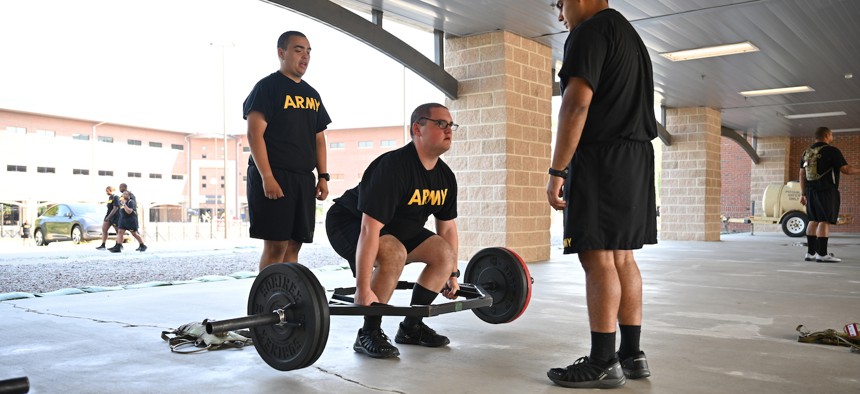
A student in the fitness track of the U.S. Army’s Future Soldier Preparatory Course works on deadlifts during a training session. U.S. Army / Robin Hicks
Army prep course has graduated 15,000 potential soldiers amid recruiting slump
With less than 30 percent of young Americans eligible for military service, the course aims to boost potential recruits' physical and academic scores.
Almost 15,000 potential recruits have graduated from an Army prep course launched a year and a half ago to boost their physical and academic scores, the service’s top enlisted soldier told Congress today.
The Future Soldier Preparatory Course at Fort Jackson, S.C., has performed well enough that the Army secretary and chief of staff “have made the decision that if we need to expand it, we absolutely will,” Sergeant Major of the Army Michael Weimer told the House Armed Services Committee. “But right now, we don't have the demand.”
The Army launched the course in August 2022 as a pilot program intended to help address the service’s recruiting crisis. At the time, the service had identified around 2,000 potential applicants who met certain requirements, such as those regarding drug use, but who struggled to meet physical or academic goals.
One year into the program, Military.com reported that 10,260 soldiers—some 95% of participants—had graduated from the course and begun basic training, the first step in an Army career.
As of today, a total of 14,700 applicants had graduated, Weimer said, with the 95 percent graduation rate continuing to hold steady. Of the 5 percent who did not graduate, 59 percent were discharged for medical conditions that existed prior to service, such as hereditary diseases, an Army spokesperson said. The overall discharge rate is similar to the one seen in soldiers going straight to bootcamp, the spokesperson added.
Weimer said the Army is studying what happens once recruits begin their first enlistment, although he said he was “very hopeful” based on what he had seen.
In 2022, the Army fell 15,000 recruits short of its goal of 60,000. The service did better the following year, but again missed its goal, swearing in 54,000 new soldiers versus the 65,000 it had hoped for. So far this year, Army recruiting numbers have improved but are still “not where they need to be,” Weimer told Congress today.
The Army has blamed its recruiting crisis in part on a decrease in the ability of young Americans to make the cut. In 2022, 23 percent of eligible Americans met Army requirements versus 29 percent in prior years, according to an Army press release.
COVID-related factors in particular have led to a decrease in students’ test scores in reading and math across the United States, with students needing the equivalent of four months or more of extra work to return to pre-pandemic testing scores. One Army recruiter in Washington DC pointed to the city’s poor education system as a factor preventing recruits from joining the Army.
The Army has also pointed to a lack of contact with potential recruits due to COVID-based restrictions as another factor in poor recruiting.
Some recruiters have also blamed a new medical intake system as making it harder to make exceptions to Army policies. Maj. Gen. Johnny Davis, head of Army’s Recruiting Command, has defended the increased medical scrutiny as keeping applicants safer.


